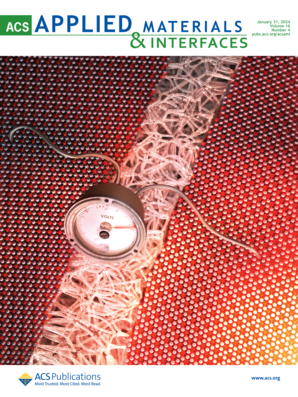热敏光敏智能平台诱导成纤维细胞样滑膜细胞和巨噬细胞凋亡,增强类风湿关节炎治疗
IF 8.2
2区 材料科学
Q1 MATERIALS SCIENCE, MULTIDISCIPLINARY
引用次数: 0
摘要
巨噬细胞激活诱导成纤维细胞样滑膜细胞(FLSs)快速增殖分裂,导致软骨基质降解和骨破坏,这是类风湿关节炎(RA)的主要病理特征。诱导这些炎症细胞凋亡以减轻炎症反应和骨损伤是一种潜在的治疗RA的策略。在这项研究中,我们开发了一个智能平台,用于协同光热治疗(PTT)和化疗,利用透明质酸(HA)修饰的热敏脂质体,负载雷公酚(CEL)和金纳米棒(gnr),称为HA/脂质-CEL- gnr,用于大鼠RA模型。在激光照射下,由于局域表面等离子体共振,GNRs表现出优异的光热效应。由此产生的温度升高不仅有效地消除了关节中过度增生的炎症细胞,而且还触发了热敏脂质体的CEL释放,显著增加了其在滑膜中的浓度。PTT与化疗的协同作用显著促进了FLSs和巨噬细胞的凋亡,有效抑制了RA微环境中的炎症反应。综上所述,多功能热敏HA/ lipop - cel - gnr代表了有前途的纳米治疗平台,能够实现光驱动的热富集和治疗剂,显著阻止RA的进展。本文章由计算机程序翻译,如有差异,请以英文原文为准。

Thermosensitive Light-Driven Smart Platform Induces Apoptosis of Fibroblast-like Synovial Cells and Macrophages for Enhanced Rheumatoid Arthritis Therapy
Macrophage activation induces rapid proliferation and division of fibroblast-like synovial cells (FLSs), resulting in the degradation of cartilage matrix and bone destruction, which are the main pathological characteristics of rheumatoid arthritis (RA). Inducing apoptosis in these inflammatory cells to mitigate the inflammatory response and alleviate bone damage is a potential therapeutic strategy for RA. In this study, we developed a smart platform for synergistic photothermal therapy (PTT) and chemotherapy by utilizing hyaluronic acid (HA)-modified thermally sensitive liposomes loaded with celastrol (CEL) and gold nanorods (GNRs), termed HA/Lipo-CEL-GNRs, for application in a rat RA model. Under laser irradiation, GNRs exhibited excellent photothermal effects due to localized surface plasmon resonance. The resulting increase in temperature not only effectively eliminated hyperproliferative inflammatory cells in the joints but also triggered CEL release from the thermosensitive liposomes, significantly increasing its concentration in the synovium. The synergistic effect of PTT and chemotherapy significantly promoted the apoptosis of FLSs and macrophages and effectively suppressed the inflammatory response in the RA microenvironment. In summary, multifunctional thermosensitive HA/Lipo-CEL-GNRs represent promising nanotherapeutic platforms capable of achieving light-driven enrichment of heat and therapeutic agents, significantly preventing the progression of RA.
求助全文
通过发布文献求助,成功后即可免费获取论文全文。
去求助
来源期刊

ACS Applied Materials & Interfaces
工程技术-材料科学:综合
CiteScore
16.00
自引率
6.30%
发文量
4978
审稿时长
1.8 months
期刊介绍:
ACS Applied Materials & Interfaces is a leading interdisciplinary journal that brings together chemists, engineers, physicists, and biologists to explore the development and utilization of newly-discovered materials and interfacial processes for specific applications. Our journal has experienced remarkable growth since its establishment in 2009, both in terms of the number of articles published and the impact of the research showcased. We are proud to foster a truly global community, with the majority of published articles originating from outside the United States, reflecting the rapid growth of applied research worldwide.
 求助内容:
求助内容: 应助结果提醒方式:
应助结果提醒方式:


